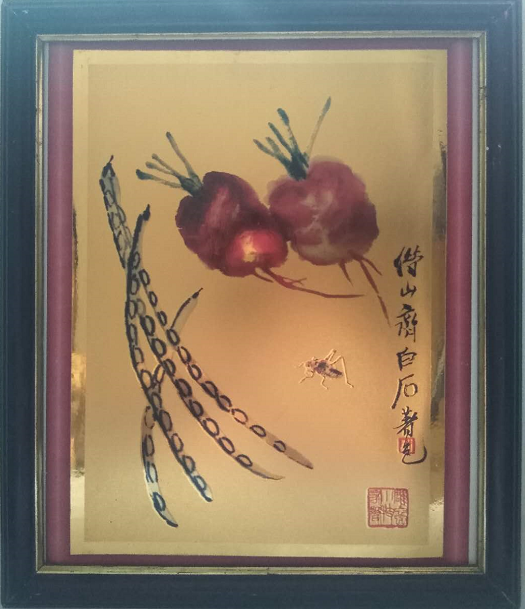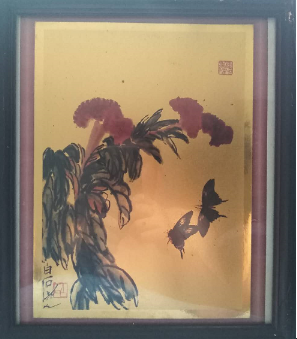齐白石(1864年1月1日─1957年9月16日),祖籍安徽宿州砀山,生于湖南长沙府湘潭(今湖南湘潭)人。原名纯芝,字渭青,号兰亭。后改名璜,字濒生,号白石、白石山翁、老萍、饿叟、借山吟馆主者、寄萍堂上老人、三百石印富翁。清白传家——齐白石笔下的蔬果情愫”陈列展在北京画院美术馆开幕,这是北京画院继齐白石的草虫、人物、梅兰竹菊松、山水、水族、花卉、书法后主办的第八个系列展,共展出北京画院藏齐白石蔬果题材作品近九十余幅。Qi Baishi (January 1, 1864 - September 16, 1957), whose ancestral home was Dangshan, Suzhou, Anhui Province, was born in Xiangtan, Changsha Prefecture, Hunan Province. The original name is Chunzhi, the word Weiqing, and the name is Lanting. Later, he changed his name to Huang, and his name was biansheng. He was named Baishi, Baishi shanweng, Laoping, hungry old man, the owner of borrowing mountain chanting hall, the old man of Jiping hall, and 300 stone printing rich man. The exhibition opened at the art gallery of Beijing Academy of painting. It is the eighth series of exhibitions held by Beijing Academy of painting after Qi Baishi's grass and insect, figures, plum, orchid, bamboo, chrysanthemum, landscape, aquarium, flowers and calligraphy. There are more than 90 pieces of Qi Baishi's fruits and vegetables works collected by Beijing Academy of painting.

白菜萝卜等“俗物”在齐白石老人笔下呈现出别样的艺术美,虽有人说他的画大多是白菜萝卜、虫虫鸟鸟,不如其他画家那样宏大有气魄。但正是这些源自生活的真实感触,才使齐白石书画饱含生命的智慧和生活的哲理。另外,齐白石笔触间流露的是那种无一不精、无一不新的特点,也为现代中国绘画史创造出一个质朴清新的艺术世界。齐老是开创 “红花墨叶派” 大写意花卉的大师,在这幅图中,红的不是国色天香的牡丹、娇艳欲滴的玫瑰、亭亭玉立的荷花,而是廉价、平凡的农家萝卜。然而,这红与黑得到更充分、更神奇的发挥;笔触色块、布局留白,皆精妙绝伦,令人回味无尽。Some people say that most of his paintings are cabbage radish, insects, birds and birds, which are not as grand as other painters. But it is these real feelings from life that make Qi Baishi's calligraphy and painting full of life wisdom and philosophy. In addition, Qi Baishi's brushwork reveals the characteristics of all refined and new, which also creates a simple and fresh art world for the history of modern Chinese painting. Qi is always a master of freehand brushwork in the "red flower and ink leaf school". In this picture, the red is not the natural peony, the delicate rose and the graceful lotus, but the cheap and ordinary farm radish. However, the red and black are more fully and magically displayed; the color blocks of strokes and the blank layout are all exquisite, which makes people have endless aftertaste.

楷体阳文雕齐小家藏白石印
大片扁平的墨叶衬托鲜红圆润的萝卜;两萝卜一深红一浅红,显出前后远近的空间距离;着色笔触弧形分布,凸显萝卜圆弧的表面;就连那一挥而就的细根、细茎,都立体而非扁平,这笔触、这功夫着实了得;最神奇的是萝卜那独具匠心的留白,足可媲美西方肖像画中著名的“伦勃朗高光”,那是萝卜反射的阳光;呈现萝卜鲜嫩欲滴的活性。黑色落款、红色印章,亦是画面的有机补充与拓展。左低右高横向展开的提款与印章,是远处的墨叶与红萝卜,前后相映成趣,构成一畦萝卜。萝卜墨叶周围大片留白,既将画面主角凸显至眼前,又营造出深度的空间,赋予画作。The bright red and round radish is set off by large flat black leaves; two radishes, one crimson and one light red, show the distance between the front and back; the arc-shaped coloring strokes highlight the surface of the radish arc; even the tiny roots and stems are three-dimensional rather than flat, which is really good; the most magical is the ingenious blank of radish, which is comparable to Western portraits The famous "Rembrandt highlight" in the painting is the sunlight reflected by radish, showing the activity of radish. Black lettering and red seal are also the organic supplement and expansion of the picture. Left low right high horizontal cash withdrawal and seal, is the distance of the ink leaves and carrots, before and after the formation of a border of radish. The large white space around the radish ink leaves not only highlights the main character of the picture, but also creates a deep space to endow the painting

白石在《鸡冠花》这幅画中以鸡冠花为题作诗:“老眼朦胧看作鸡,通身毛羽叶高低。客窗一夜如年久,听到天明汝不啼”。寥寥数语便刻划出了鸡冠花花似鸡冠、叶如毛羽的特质。仔细比较白石老人所画的公鸡,鸡冠、羽毛的画法和位置关系与鸡冠花颇为相似,确能感受到两者之间的相通之处,使人不得不赞叹白石老人对事物独到的观察角度。Qi Baishi wrote a poem with the title of cockscomb in the painting "cockscomb flower": "the old eye is hazy as a chicken, and the whole body is full of feathers and leaves. The guest window is like a long night, and you don't cry at dawn. ". In a few words, the flowers of Celosia cristata are like cockscomb, and the leaves are like hairiness. A careful comparison of the rooster painted by the old man Baishi shows that the drawing method and position relationship of the cockscomb and feather are quite similar to those of the cockscomb flower. The similarities between the two can be felt, which makes people have to admire the unique observation angle of the old man Baishi.

篆体阳文:子和画齐落款白石遊白石印
鸡冠花是一种野花,在深秋的时候,篱边园侧看到一二朵,颇具萧疏的秋意。所以画家画这种花,也常用疏落的笔调来表现。此图中,白石老人把鸡冠花描绘得美轮美奂。红色花朵以胭脂数笔绘画,不但浓艳,更表现了花朵的肥厚感和细毛的质感。花叶用偏轻的绿色敷染,再以浓淡不同的墨线钩勒,空间关系表达准确自然。使丰满的花叶蓬松铺满茎干。这种红绿搭配易流于俗气,但在白石老人笔下却成为了一种用色范式,为人所喜爱。Cockscomb is a kind of wild flower. In late autumn, we can see one or two flowers on the side of the fence, which is quite sparse. Therefore, painters often use loose style to express this kind of flower. In this picture, the old man Baishi depicts the cockscomb beautifully. Red flowers are painted with rouge, which is not only rich and colorful, but also shows the feeling of thick and fine hair of flowers. The flowers and leaves were dyed with light green, and then tied with different shades of ink. The expression of spatial relationship was accurate and natural. Make the plump flowers and leaves fluffy and cover the stem. This kind of red and green collocation is easy to be vulgar, but it has become a color paradigm in the works of Baishi old man and

《杨梅图》是现代著名书画家齐白石的常用题材创作之一,笔精墨妙,形神兼备,该幅画中,满盛着熟透的杨梅,馥郁的果香,果实的腥红色泽,在烫金纸烘托下,画面显得格外活泼而抢眼,齐白石笔下的杨梅,笔精墨妙,形神兼备,使得画面更富张力和延伸感。它冰清玉洁一身傲骨尤其为世人钟爱。通观此画,疏密有度,虚实相谐,体现了齐白石对构图极高的经营能力。The painting of red bayberry is one of the common themes of Qi Baishi, a famous modern painter and calligrapher. The painting is full of ripe red bayberry, fragrant fruit fragrance and fishy red color of fruit. Under the foil of gilt paper, the picture is particularly lively and eye-catching. Qi Baishi's waxberry has both fine ink and shape, which makes the picture more tension and extension. I love her very much. Throughout the painting, there is a degree of density and harmony between virtual and real, which reflects Qi Baishi's high management ability of composition.

楊梅配气字(代表本品为传家绝版)白石印
浓厚的乡土气息,纯朴的农民意识和天真浪漫的童心,富有余味的诗意,是齐白石艺术的内在生命,而那热烈明快的色彩,墨与色的强烈对比,浑朴稚拙的造型和笔法,工与写的极端合成,平正见奇的构成,作为齐白石独特的艺术语言和视觉形状,相对而言则是齐白石艺术的外在生命。现实的情感要求与之相适应的形式,而这形式又强化了情感的表现,两者相互需求、相互生发、相互依存,共同构成了齐白石的艺术生命,即齐白石艺术的总体风格。Strong local flavor, simple peasant consciousness, naive and romantic childlike innocence and poetic flavor are the inner life of Qi Baishi's art. The warm and bright color, the strong contrast between ink and color, the simple and naive modeling and writing, the extreme combination of work and writing, and the ordinary and strange composition are Qi Baishi's unique artistic language and visual shape The external life of Baishi art. The realistic emotion demands the form that adapts to it, and this form strengthens the expression of emotion. The two need each other, grow and depend on each other, which together constitute Qi Baishi's artistic life, that is, the overall style of Qi Baishi's art.

明代,织布工使用了多达40种不同颜色的纬纱的精心制作的织机,并结合了扁平的金(烫金纸)条,缠金的线以及虹彩孔雀羽毛来织锦。永乐年间(1403-1424)投入了大量资源来制作外交礼品,包括佛教用纺织品,这种做法一直延续到宣德元年(1426-1435)。明万历年间(1572-1620年在位)的墓葬发掘出两套完整的未切割的机织丝绸,用于龙袍,以及丝绸织锦和图案化的纱布,这些织锦被标记为南京和苏州的帝国工坊的产品。In the Ming Dynasty, weavers used elaborate looms of up to 40 different colors of weft, combined with flat gold (gilding paper) strips, gold threads and iridescent peacock feathers to weave brocade. During the Yongle period (1403-1424), a large amount of resources were devoted to making diplomatic gifts, including Buddhist textiles, which lasted until the first year of Xuande (1426-1435). Two complete sets of uncut woven silk were unearthed from the tombs of the Ming Dynasty
联系人:伍安政先生
电话:13017785802
